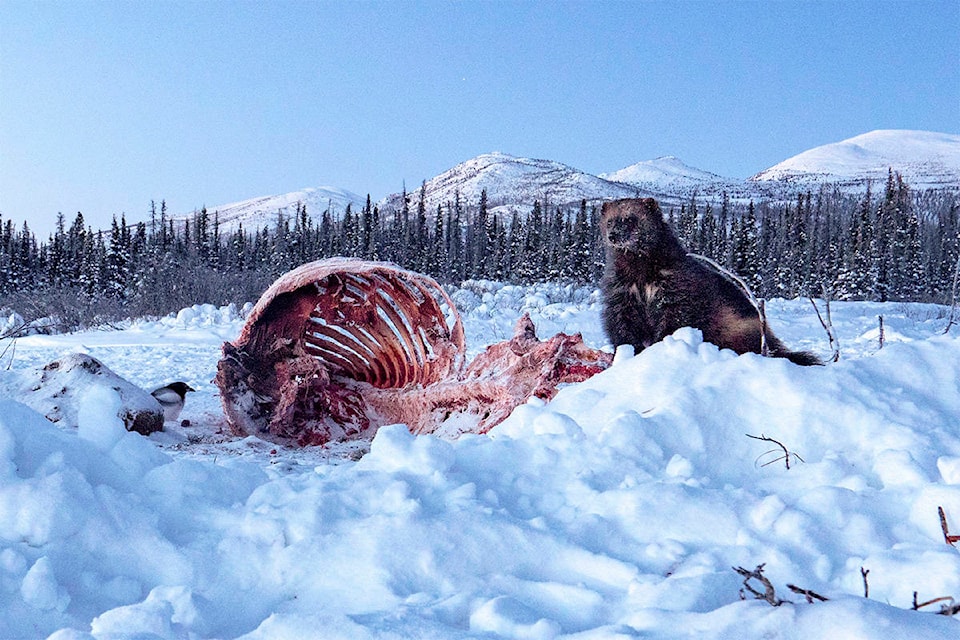Peter Mather
Special to the News
The mountains of northern Alaska gradually recede into a vast and seemingly eternal white plain stretching for miles until culminating at the Arctic Ocean. This coastal plain, known as the North Slope, appears to be a lifeless barren region of the world. It is remote and when temperatures drop into the -50 C range mere survival seems beyond the reach of any living creature.
This is where the wolverine thrives. Known as one of the toughest animals on the planet, wolverines have been known to chase down a caribou for 30 miles until the exhausted 200-pound animal collapses and falls prey to the tenacious 30-pound snow machine.
Wolverines, or Qavvik in Inupiaq, are supremely adapted to snow and have clearly defined territories. Within these boundaries, they dig numerous snow holes that expand into a network of underground tunnels. The snow holes serve as natal dens, rendezvous sites, food caches and are their only reprieve when being chased by their foremost predator – the Arctic wolf.
The wolverine’s relationship with the Arctic wolf is a catch-22. While wolverines are vulnerable to the wrath of Arctic wolves, they also depend on the Arctic wolf for much of their food source. Wolves are incredibly efficient predators of caribou and moose, but after their initial feast on a freshly killed ungulate, the carcass slowly freezes and it becomes difficult for a wolf to rip into the frozen fresh.
This is where the wolverine comes into its own. A wolverine’s jaws enable it to easily tear into frozen carrion in a way no other animal – save a grizzly bear – can. The wolverine’s jaws are so strong they can easily crack the bones of a moose. Once a wolf abandons its kill, wolverines will use their noses, known to scent mountain goats buried by avalanches under 20 feet of hard-packed snow, to find the abandoned kills sites.
Over the last three decades, studies of threatened wolverine landscapes in the lower 48 states have suggested that the primary requirement for healthy wolverine populations is an abundance of late spring snowpack. Maps showing late spring snowpack along the border with Canada correlate almost exactly with the remnant wolverine territories on the continental United States.
Wolverine biologist Tom Glass spent three field seasons in northern Alaska studying late spring snowpack and wolverine dens to determine what depth of snowpack is ideal for wolverines. He also studied how wolverine populations in the lower 48 and Alaska might be affected by snowpack changes brought on by climate change.
On top of the threat facing wolverines from petroleum-based climate change, industry infrastructure has spider-webbed across the North Slope and is set to expand into ANWR. Glass is also studying the effects of industry to determine if wolverines on the tundra have adapted to the roads and pipeline, or if wolverines define their territories by avoiding the industries’ infrastructure.
For the local Inupiat communities along the coast, wolverine furs are prized by trappers and whalers alike. During whaling season along the coast, every second man, woman or child has a parka trimmed with wolverine fur around the hood. Wolverine parka trimming or ‘ruff’ is well known for its ability to whisk moisture from breath without freezing up.
For the hardy Inupiat people of the Arctic Coast, climate change and oil and gas development also provide an oddly conflicting balance of life. The industry sustains the strong economy on the North Slope in the short term, while the effects of climate change brought on by the use of oil and gas permanently threaten their culture and their homes, which will eventually be lost to coastline deterioration in the coming decades.
So little is known about this fascinating animal. We are just beginning to understand and appreciate their story through biologists like Glass and through the Inupiat trappers on the North Slope.
Contact the Yukon News at editor@yukon-news.com
